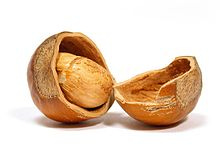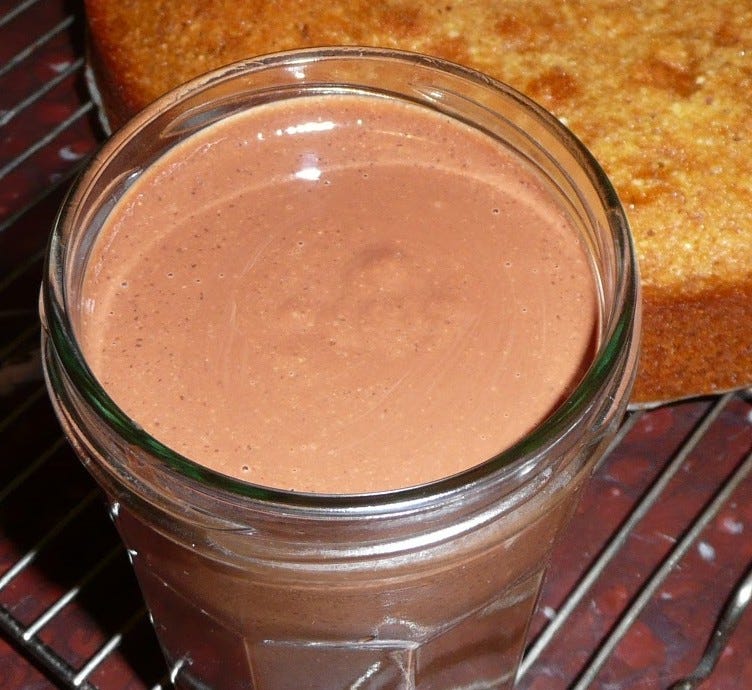Plain nuts, but not crazy
A palm oil-free recipe for a hazelnut spread 'Nutella' cake
Rumour has it some of our supermarket chains are selling a Ferrero Rocher Easter Egg. I am on the trail, so far with no success. I am buying it for me, and some secret scoffing.
I don’t know why, but Ferrero Rocher chocolates are deemed to be low rent. English class distinctions extend even to confectionery. Bendicks Bitter Mints? High end luxury. After Eight Mints? Very plebeian. But I can’t imagine anything more clever in contrasts of texture and smooth taste than an Easter egg made from Nutella in a crispy wafer shell.
It’s only recently that I learned that Ferrero Rocher are responsible for Nutella. It was created in 1946 as a response to a shortage of cocoa after the Second World War. Piero Ferrero, owner of a small Italian pastry shop in Alba in Piedmont, came up with a sweet paste made from local hazelnuts, sugar and a smidgin of cocoa powder that he called Supercrema Giandujot and sold in a jar. His grandson, Giovanni, records that twenty years later, his own father believed that improved technology in the industry could take the company further. Using the new processes, in 1964 the cream was relaunched as Nutella.
There aren’t enough hazels in Piedmont to supply what is now a huge international Ferrero industry. Turkey grows nearly 70 percent of global supply of the nut and Nutella takes 25 percent of it. The republic of Georgia is another major supplier, exporting between August last year and this January 12,200 tonnes, a 17 percent increase on the previous six months.
The two nations are not the only growers of hazelnuts. As anyone who’s spent the summer in Scotland fighting off the midges (No See ‘Ems) that feed off the catkins of hazel trees, they also grow in cooler climes. On the tiny and isolated island of Colonsay in the Inner Hebrides off the west coast of Scotland, there’s evidence that large-scale Mesolithic nut processing took place around 6000 years ago. A large shallow pit was discovered in 1995 filled with hundreds of thousands of burned hazelnut shells, suggesting a community with a largely vegetarian diet.
Nutella hadn’t really featured in my experience until moving from Moscow to Washington DC with two small children. With underhand cunning expressed in tears, stamping of feet and a refusal to eat, they persuaded me to stock a supply. I kept it for special treats on an upper shelf of a cabinet which required the navigating of a cumbersome stool round the intrusive island unit to reach.
One afternoon, I stretched up for the jar to make sandwiches for the latest bunch of after-school squealers. Lifting it off the shelf, my hand shot up and bashed against the roof of the cupboard, similar to the way your ankle crumples if you miscount the steps down a staircase. Confused, I opened the Nutella. But for a thin and unbroken smear that lined the glass, the insides had been completely hollowed out by fat little fingers.
I rationed the stuff because not only is it full of sugar, but also equally unhealthy palm oil that makes it spreadable. The creation of palm oil plantations has led to massive deforestation. The pesticides used liberally to manage them are released into the soil and the water then drunk by rhinoceri, elephants, orangutans, Sumatran tigers - and people.
I’ve worked out how to make a hazelnut spread without much trouble and with no palm oil yet easy to spread. You can use it to create Nigella Lawson’s Nutella Cake whose recipe follows, a good one for Easter.
But I also use my spread on a simple Victoria sponge base as well as in the middle to sandwich two together, with a melted chocolate glaze on the very top.
150g/5½ oz hazelnuts (dried, not just off the tree fresh and milky)
2 tablespoons vegetable oil
3 tablespoons good-flavoured honey
1 tablespoon unsweetened quality cocoa powder
½ teaspoon vanilla extract
250g/½ lb 70% chocolate, broken up
Preheat oven to 175C/350F.
Toast the hazelnuts on a baking sheet in the oven for 10-12 minutes until they’ve browned a little and their skins blister. Pour them onto a kitchen towel, fold it over and rub enthusiastically to get rid of as much loose skin as possible. If you take it outside to open, you can blow the skins off. Otherwise, just try to keep the skin bits away from the exposed nuts.
Cool the nuts then grind them in a blender or processor to form a paste. Add all the remaining ingredients except for the chocolate and blitz again until completely smooth.
Melt the chocolate in a saucepan over simmering water, stir until smooth and cool a little then add to the mix and blend again. Pour into sterilised jars. It will thicken as it cools.
Then store on the highest shelf you have.
I’m not convinced by the chunky burnt hazels topping Nigella’s cake - wouldn’t a sprinkling of crushed ones look better than those semi-charred lumps?
6 large eggs, separated
pinch of salt
125g/4½oz soft unsalted butter
400g/14oz Nutella or my hazelnut spread, above
1 tablespoon Frangelico (or rum or water)
100g/3½oz ground hazelnuts
100g/3½oz dark chocolate, melted
For the icing
100g/3½oz hazelnuts
125ml/4 fl oz double/heavy cream
1 tablespoon Frangelico, rum or water (though I’ve also used coffee…)
125g/4½oz dark chocolate (no less than 70 percent cacao, in my view)
Preheat the oven to 180C/350F.
In a large bowl, whisk the egg whites and salt until stiff but not dry. In a separate bowl, beat the butter and Nutella together, and then add the Frangelico (or whatever you're using), egg yolks and ground hazelnuts.
Fold in the cooled, melted chocolate, then lighten the mixture with a large dollop of egg white, which you can beat in as roughly as you want, before gently folding the rest of them in a third at a time.
Pour into a 23cm/9 inch round greased and lined springform tin and cook for 40 minutes or until the cake's beginning to come away at the sides, then let cool on a rack.
Toast the hazelnuts in a dry frying pan until the aroma wafts upwards and the nuts are golden-brown in parts: keep shaking the pan so that they don't burn on one side and stay too pallid on others. (I find this done more evenly and more easily in the oven.) Transfer to a plate and let cool. This is imperative: if they go on the ganache while hot, it'll turn oily. If your hazelnuts have skins on then after toasting in the frying pan transfer them to a slightly dampened tea towel and rub them while they are still warm to remove the skins.
In a heavy-bottomed saucepan, add the cream, liqueur or water and chopped chocolate, and heat gently. Once the chocolate's melted, take the pan off the heat and whisk until it reaches the right consistency to ice the top of the cake. Unmould the cooled cake carefully, leaving it on the base as it will be too difficult to get such a damp cake off in one piece.
Ice the top with the chocolate icing, and dot thickly with the whole, toasted hazelnuts. If you have used Frangelico, put shot glasses on the table and serve it with the cake.






Your Nutella would be safe with me until the end of time! Hazelnut isn’t on my lust list. As for melting chocolate my Breville Control Freak induction hob makes it easy to dial in very low temperatures! All that and it looks like chocolate is on the doomed charts!
Curious about your choice of vegetable oil. I do olive oil, avacado oil and butter. But when neutral vegetable oil is preferred I am flummoxed!
Love the story about your theatrical young squealers. When my very spoiled only was told it was a grilled cheese sandwich for lunch, he had a full throttle, on the floor hissy fit crying “I don’t want a girl cheese sandwich. I want a boy cheese sandwich!”
When making ganache, I'd advise against trying to melt chocolate in a pan with even just a tablespoon of water in it--it will sieze up and get grainy. Heavy cream, brought to a simmer is the preferred base, and liquor added after the cream and chocolate are smoothly amalgamated. As someone who has known the heartbreak of siezed chocolate, this jumped right out at me. There is a notable exception to the rule of melting chocolate with water: Heston Blumenfeld's method for making chocolate mousse involves pouring boiling water over chopped chocolate and whisking until smooth.